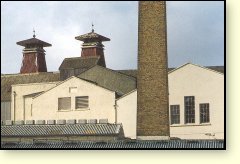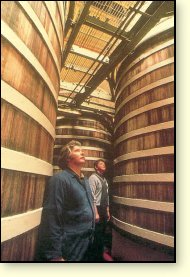
 |
|
Location: Port Ellen, Isle of Islay PA42 7DZ
Roads: On A846 at Dunyveg
Hours: All visits by appointment
Phone: 01496-302250
|
Text from The Whisky Trails, Copyright © Gordon Brown 1993:

Traditional wooden fermentation vessels - on a grand scale - are in use at Lagavulin.
|
Lagavulin is one of the great whiskies of Scotland, a grand and complex spirit that epitomises the richly peaty style that is traditionally associated with Islay. It is produced on the Kildalton shore in the south-east of the island with Port Ellen just to the west.
Perhaps the first documented record of Lagavulin was when the folk-hero Scottish king, Robert the Bruce, fled here after defeat in battle against the Earl of Pembroke. Further testimony to tempestuous times is the ruin of Dunyveg Castle which still stands guard over Lagavulin Bay; in the 14th century it was a stronghold of the Lords of the Isles. In Gaelic Dun-naomhaig (Dunyveg – mh is pronounced v in Scots Gaelic) means ‘fort of the little ships’, referring to the fact that the castle had a sea-gate as well as an entrance on the land side. The Lords’ vessels could be drawn up for repair inside the safety of the walls.
The distillery lies below the Dunyveg promontory and covers about six acres on Lagavulin Bay. It is the sole surviving unit of a bustling illicit distillation complex that spread along the foreshore in the 1740s. There were almost a dozen bothies - small primitive distillation shelters - ranged alongside a mill in a little hollow in the ground, the laggan mhouillin of the whisky’s name. By 1817 there were just two distilleries on the site and by the 1830s only one remained.
In 1867 the distillery was bought by the company of Peter Mackie, a dynamo of a man who had studied distillation techniques at Lagavulin. He went on to create the White Horse Scotch brand and used Lagavulin malt whisky as its heart – which is still the case today. Mackie was later knighted for his business achievements. Over the decades, buildings were added and by the end of the century the distillery was an interesting patchwork of architecture from several different periods. At that time few distilleries sold their whisky as unblended single malts; Lagavulin did so, however, and the product was very highly regarded. It sold in Glasgow, England and the colonies.
One of his whisky projects at the distillery was Malt Mill – an effort to produce an authentic, traditional ‘old-fashioned’ malt whisky differently from that yielded by the ‘advanced’ technology of his day. In effect he was trying to maintain the character and high quality of the old smugglers’ whiskies. Even in those days, there were feelings that the product was being altered by the volume-production techniques being used in distillation. Malt Mill was a separate distillery set up on the same site in 1908. It was small-scale, used only peat – no coal – to dry the malt and the whisky was completely different in style from that of Lagavulin itself. Production stopped in 1960 but the Malt Mill stills were used for a while in the production of Lagavulin before being replaced. The distillery’s visitor centre is the old Malt Mill Maltings.
The twin pagoda heads are still in place, lending that distinctive and vaguely mysterious quality to distillery exteriors. The pair of large grinding stones in position outside the distillery were used in the Malt Mill operation. The pier is a reminder of the attractive little ‘puffers’ that used to ply between the distillery and Glasgow, transporting barley, coal and casks, in the first half of the century.
The island distilleries that belonged to United Distillers had their own puffer for a while, a famous craft called the SS Pibroch. It acquired the nickname of the ‘Fleetwood Lifeboat’ in 1937 when it rescued crewmen from a trawler based in the port, which had foundered on the rocks off the Scottish islands. During the months that followed, the Pibroch crew were overwhelmed with boxes of fish gratefully pressed upon them by passing trawlers. During the war, a German U-boat surfaced near the Pibroch and an officer scrutinised it through binoculars from the conning tower. The submarine did not intervene but the officer might well have considered a boarding party had he known the Pibroch was Glasgow-bound with a cargo of Lagavulin whisky. Before the pier was built, full casks of spirit used to be floated out to the boats at anchor. Roll-on-roll-off ferries now enable road-lorries to transport all supplies to and from the distillery.
Part, at least, of Lagavulin spirit’s individuality comes from the unique shape of the two pairs of stills, which are noticeably broad-necked. Also, the lead-off pipes (the lyne-arms) from the tops of the stills are more steeply angled than those in other distilleries. Water is brought down to Lagavulin from the two Solan lochs on the hillside above.
The Whisky
Text from The Whisky Trails, Copyright © Gordon Brown 1993:

Traditional wooden fermentation vessels - on a grand scale - are in use at Lagavulin.
|
Lagavulin has the same broad Islay characteristics as Laphroaig – weight, impact, power, concentration – but the details are different. There is a sweet’n’spicy dash to the malt, and a definite elegance that helpfully keeps the complexity in hand. Until recently Lagavulin was bottled at 12 years and 43% vol. but this stretched to 16 years when it became part of the company’s Classic Malts range. There is also a 14-year-old from an independent and one of the specialist chains in the UK.
Source of water
Solan Lochs